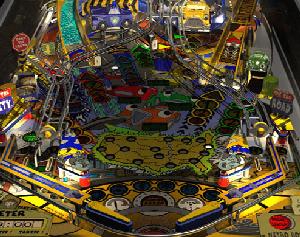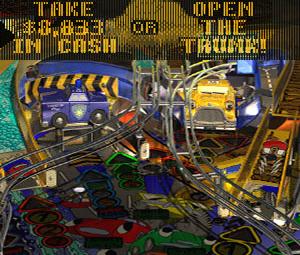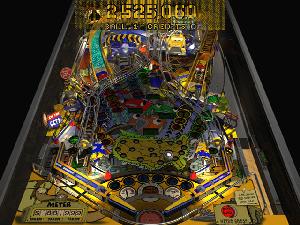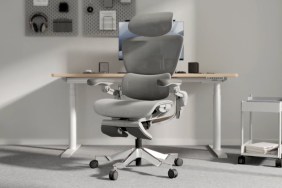Balls of Steel.
Remember pinball? Those glass covered, angled tables with the flashy lights and
sounds? Sure you do. Ever since I could remember, I wanted to own a few, just
like that kid in Silver Spoons. Pinball games in your living room and a
big toy train running through your house are the signs that you have truly arrived.
Well, times have changed. Now that little rich kid from
Silver Spoons is working the mean streets of
New York as a cop. Arcades are being replaced by home systems. Yet still,
only the bourgeois have their own pinball machines.
What’s the prescription? Well, you could try Empire’s Pro Pinball Series
for temporary relief. It will give you a simulation of pinball – the key word
being “simulation.” The series consists of 4 titles, each being a different pinball
table. The two I’ll be checking out in this review are Big Race USA and
Fantastic Journey.
In a nutshell, Big Race USA is a ramp driven game of pinball, whereas Fantastic
Journey is more trigger-centric.The former is filled with cartoonish graphics
– bright colors and neon lights make for a clean layout. This table is better
suited to the younger or newer pinballer, while Fantastic Journey‘s darker
tones and graphics are a good match for the old-schoolers. Plus, the 70’s-styled
music is much better than Big Race‘s.
When it comes down to it, Fantastic Journey is the better of the two,
though I was a better player on the Big Race table.
The same game engine lies behind all the Pro Pinball games, and the crux of
the matter is found in the physics. Just watching that metal ball glide around
as you play will remind you of all those mathematical functions and figures
that you slept through in high school. From the gravity that pulls down on the
ball to the applied force of a powered flipper, the physics are very good.
And the control is easy enough – buttons for the left and right flippers and the launch key. Plus, you can tilt the table left, right, or forward. Analog support for tilting would have been better, as it feels weird using digital buttons – like you can’t really control your tilt.
The backgrounds are static whilst your metal balls skim and shoot across the surface of the table. Both games are done up in sharp, clear graphics that convey the table in a way that can only truly be topped by an actual table. You’ll find all the glowing lights and moving parts, and the metal balls have that bright metallic sheen all throughout.
There’s also a worldwide scoreboard. After you beat the game, you can take a password and enter your high score into a website. Now you can still have some semblance of pizzeria bragging rights.
All in all, Empire certainly did some things right. But let’s not forget the keyword:
simulation.

Simulations will always fall short of the real thing. Let’s say they create the
ultimate flight simulator, a setup of monitors and motion simulators that recreate
every facet of flying a jet airplane. But no matter how hard you try, you can’t
replicate things perfectly. And for that reason alone, you spend most of your
time noticing the failures of the simulation rather than the successes.
The same holds true in the world of pinball games. You can recreate every
feature and make it feel as close to playing on a real table as possible, but
it simply isn’t the same as pulling back and letting that ball fly. Pinball
is a very tactile, involved game. It’s nigh impossible to recreate looking up
for quick glances at the scoreboard while keeping tabs on the table – and your
beer perched on top of the glass.
Since a TV screen and a controller aren’t the same as a pinball table, why not
make a non-simulation mode as well? Why take advantage of the medium? Even the
original Pinball for the NES did that. Remember those penguins that you
have to hatch? Remember the princess that Mario had to catch?
NES Pinball still rocks, and despite the obvious technological discrepancy,
may be a better game. Pro Pinball should include both a simulation and
an adventure mode. Or why not add more tables per disk?
There’s also a problem with slowdown when you get 3 balls into play. Bad medicine, considering that multi-ball is sort of the point of every pinball machine.
Like real pinball, only the truly committed and impassioned will keep playing
in the name of a higher score. On a real table I’d feel more compelled to keep
going, but with these games, I felt inclined to stop after a few games. The need
to win free games and the atmosphere of a dimly lit arcade isn’t there.
But for those who have pinball in their blood, that dying breed unable to afford the full table, both of these games will satisfy your itchy trigger fingers. From Soho down to Brighton, you’ll certainly find some throwback love here.

-
Good physics
-
Decent simulation
-
But it's still just a simulation
-
Doesn't take advantage of the medium
-
Slowdown when there are too many balls











